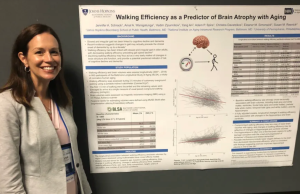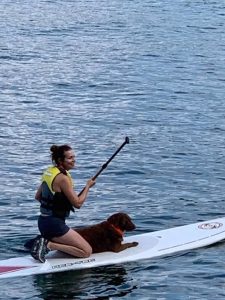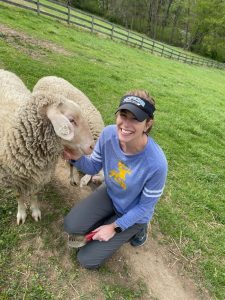Core Faculty with the Center on Aging & Health (COAH), Jennifer A. Schrack, PhD, is our Summer 2023 COAH Champion, and we are delighted to bring you this interview so you may learn more about Dr. Schrack as a person as well as a professional.
Dr. Schrack is an Associate Professor with the Johns Hopkins University Bloomberg School of Public Health with a primary appointment in Epidemiology of Aging, and she has a joint appointment in the School of Medicine. She studies movement and health, and, in addition to COAH, Dr. Schrack is affiliated with these Johns Hopkins University research centers: Welch Center for Prevention, Epidemiology and Clinical Research; George W. Comstock Center for Public Health Research and Prevention; and Alzheimer’s-related Resource Centers for Minority Aging Research.
Additionally, she is the Johns Hopkins University co-PI with the National Health & Aging Trends Study (NHATS); you may be interested in a prior COAH Blog about her involvement with NHATS, which you may access here. In it she discusses perspectives as an epidemiologist studying movement and health, as well as the nexus of medicine and public health, and Dr. Schrack describes very interesting studies using NHATS data and possible implications for future work in the field.
Tony Teano: Thanks so much for taking the time to meet for this interview—Congratulations on being named the Summer 2023 COAH Champion! For those who may not know you well, please tell us about your background, education, and path to COAH.
Dr. Schrack: My undergraduate degree is actually in accounting! I graduated from Villanova University, and I liked math, numbers, and statistics—those kinds of courses. But I really didn’t know what I wanted to do for a career.
My advisor suggested I try accounting because it is very analytical, numbers-focused, and I enjoyed those classes. It led me to a pretty prestigious corporate banking training program, and I had a job set up before I graduated. But when I graduated, I found out that I didn’t like the job–I was working as a financial analyst for a bank in Philadelphia, and I did that for 3 years… but I didn’t like it at all. I was just bored. I was managing a portfolio of clients that included the University of Pennsylvania, Thomas Jefferson University, and Pennsylvania Hospital. I found I was more interested in the work that my clients were doing rather than just providing their financial services. So, I thought maybe I didn’t like “Corporate America,” and I got a job at a smaller real estate investment firm—and that was even worse!
During that time, I decided I needed to make a change, and I started taking night classes. I had always been interested in activity and health, but it was more like a hobby—I always enjoyed sports as a kid. I never really thought about it as a career. So, I started taking classes: anatomy; physiology; and nutrition. I just loved it. I was fascinated by all of them, so I applied to Master’s programs in Kinesiology, which is movement science, and was accepted to the University of Michigan, where I primarily focused on Cardiovascular Health and Obesity. While there, I started working on a study with Dr. Neil Alexander, who is a geriatrician at Michigan, and he was very interested in preventing falls in older adults, and how strengthening lower extremity leg muscles could help prevent falls. I thought it was a fascinating concept for a study, and that something so simple could make such a big difference in people’s lives. That led me to a job at as an Exercise Physiologist at the National Institute on Aging, where I worked for the Baltimore Longitudinal Study of Aging with Dr. Luigi Ferrucci when he first took over. That was my introduction to Epidemiology, and I loved the concept of following people for life to try to understand who ages well, and why.
That led me to pursue my PhD in Epidemiology at Johns Hopkins University. It was hard coming from a laboratory science background, and—at first—I really wasn’t sure I belonged. It took about 6 months to really feel like this is where I belonged. In the second year of my program, I was accepted into the Epidemiology and Biostatistics of Aging Training Program run by Drs. Linda Fried and Karen Bandeen-Roche, and that’s when it started to come together for me. I found that I had always been interested, like I said, in activity, but I realized I was also interested in mobility and disability.
I grew up very close with both my grandmothers, who lived incredibly independent and mobile lives until about the age of 93. Towards the end, I saw them struggle mostly with mobility, and how restrictive it was for them. In a way, that was the foundation for my motivation for trying to understand this link between movement and health.
I started studying gait speed because that was the “darling” of gerontological researchers at the time. And then, through the years, I got into newer technology—such as wearable devices—and trying to understand how people move in their own environment, how much they move, and their patterns of movement, and what that  could tell us not only about their mobility, but also their cognitive health and their general physical health. At the time, I found it fascinating because it was a newer way to gather research data and was a wide-open field; today, it is not really new anymore—it has been around for a good decade—but the methodology is still new. We’ve come up with a lot of new ways to look at this data, and ways to help understand what’s going on in older people’s lives in a more in-depth way than simply measuring how they function in a clinical setting.
could tell us not only about their mobility, but also their cognitive health and their general physical health. At the time, I found it fascinating because it was a newer way to gather research data and was a wide-open field; today, it is not really new anymore—it has been around for a good decade—but the methodology is still new. We’ve come up with a lot of new ways to look at this data, and ways to help understand what’s going on in older people’s lives in a more in-depth way than simply measuring how they function in a clinical setting.
Tony Teano: Can you give us an example of your research in this space?
Dr. Schrack: I think the article that is probably most known is a review paper on Assessing Physical Activity in Older Adults. I wrote it with Dr. Tammy Harris before she retired from NIA. And I’m proud of it because it set the tone for trying to understand physical activity in older adults in a different way. Traditionally, physical activity research has focused on how active are you in terms of your MVPA—your “Moderate to Vigorous Physical Activity.” Are you meeting the Government guidelines of 30 minutes of MVPA a day? That is an important question, but for older people, it may not be the most effective way to gage how active they are…. Whether they meet the guidelines or not may have a lot to do with their functional ability. We wrote this review article saying, “There are other ways to look at this, and these ways may actually tell us more about people’s health than simply quantifying how much time they spend at a certain intensity of exercise.”
More recently, we’ve been taking these methods that we developed over the years and applying them to specific research questions around physical and functional decline. One example is a recently published online ahead of print paper that was part of a clinical trial run by Dr. Larry Apple, STURDY, where we looked at vitamin D supplementation for prevention of falls in older people. Specifically, the question was, “If we give vitamin D supplements to older adults who are a vitamin D deficient, will this affect their falls risk?” We found no effect on falls. But I also convinced Larry it was important to understand how much the participants move. People who fall have to be moving. You can’t fall If you’re just sitting in a chair. You have to be actually walking or moving in order to fall. Therefore, we put accelerometers on everybody in the STURDY trial. What we found was very interesting: giving people who have low serum vitamin D supplements didn’t do anything to attenuate their physical activity decline. Specifically, people with vitamin D deficiency declined more in their physical activity during the study, but the supplementation did not slow this decline. This is a sign that those with low vitamin D may be in an accelerated state of decline in terms of their health, and but giving them vitamin D doesn’t seem to matter. Other therapies are needed.
It is a little frustrating that we didn’t find an answer, but at the same time I think it’s very, very interesting. It shows us the complicated kind of heterogeneity that happens at the end of life.
Tony Teano: After you went into accounting/finance and realized it wasn’t your calling, what was your “Ah-Ha!” moment when everything clicked that examining the relationship between movement and health was in fact your path? How did you know?
Dr. Schrack: That’s a great question, I think I was fascinated by the fact that we can understand so much about a person’s health by just looking at how much they move and how quickly they move. And that this is true, across species, not just in humans. It’s true in animals. If you’ve ever had a dog or a cat, you know how they move less, and they move slower as they get older. It’s true in mice, too. And fish swim slower as they get closer to death. So, it crosses species—it isn’t just true in humans. Decline of movement is really predictive of so many outcomes. And I find that fascinating—that something so relatively simple like measuring how much someone
moves or how fast they move can tell us more than many clinical tests. This work allows me to combine my two graduate degrees—my kinesiology degree and my epidemiology degree. And then there’s my undergraduate degree, which was really numbers-focused and very analytical. I use a lot of those skills every day as well.
Tony Teano: Knowing what you now know about this profession and your career path, what advice would you give to college students today who are gifted in math and science and who are interested in health, and how the body moves and ages?
Dr. Schrack: That’s a hard question because I never would have thought of studying movement as a career path! Looking back, if you think about it, it’s just not something anyone would have ever thought of at that time, and the college pathways at that time very clearly lead to practical jobs in statistics, accounting and finance—or teaching those subjects. And I really enjoyed statistics, so the path I pursued made sense. However, there are a lot of options out there that I just didn’t know existed. Now, young people are more naturally going into the quantitative sciences. Today, I’d definitely encourage students with similar interests to mine to think about how valuable mathematics is as a quantitative science. Also, I would encourage them to get creative and “think outside of the box” to find possibilities where their personal passions and professional aptitudes overlap. Consider setting up a brief Zoom “informational interview” or exchanging emails with someone doing something unique in the field that seems appealing. Additionally, I think now there’s more emphasis on STEM, especially—women and minorities in STEM. There’s a lot of options and opportunities out there! Actively seek them out!
Tony Teano: Thank you for those suggestions, Dr. Schrack! I hope those starting to dream about their futures in this field will consider your insights. You have a wealth of professional knowledge and experience to offer those suggestions and discovering and really making your own way.
Now, if you don’t mind, I’d like to turn to another side of you: “Jennifer”—who you are outside of work, as a real person. What activities do you like to do?
 Dr. Schrack: I like to be active. I am a runner. I like to garden. I like to ski both on snow and water. I like to sail. We have a lake house in upstate New York on Otsego Lake, and we spend as much time as we can there in the summer. We ski, we paddle board, we swim, we sail. It’s really a nice place to go and relax and unplug, and renew ourselves—and get ready to face the world again.
Dr. Schrack: I like to be active. I am a runner. I like to garden. I like to ski both on snow and water. I like to sail. We have a lake house in upstate New York on Otsego Lake, and we spend as much time as we can there in the summer. We ski, we paddle board, we swim, we sail. It’s really a nice place to go and relax and unplug, and renew ourselves—and get ready to face the world again.
Tony Teano: You say “we”—who are “you”?
Dr. Schrack: My husband, Nick, who is faculty at Towson University in Kinesiology. We met and worked in the same lab in Michigan. And then I have three daughters: Ella, Kate, and Leah. Ella is 13. Kate and Leah are twins, who are 10. And we take our dog and two cats to the lake, too. We all love it and have a great time.
Tony Teano: That sounds like a great time for one and all! Tell us about a few of your favorite things—a movie or a book, etc.
Dr. Schrack: One of the best books I read recently was the book Educated: A Memoir by Tara Westover. It’s a true story about a woman’s fight for her education. It was amazing to me because it’s something so many of us take for granted. We grow up with education in our lives, and this was a story about a woman who grew up in rural Idaho, and her parents didn’t believe in formal education—and that’s all she wanted, and so it was kind of her fight for education. It it’s a really good book.
Tony Teano: This sounds like a great story! Other favorite ways to pass time? 
Dr. Schrack: We are a game family! My husband and I really like to play cards. We’re always looking for people to play cards with. Also, we spend a lot of time cooking, baking and canning. My kids like it when I cook for them, and a favorite meal I cook that’s a hit is Arugula Pesto.
Tony Teano: I know that you have several animal companions. Tell us about them.
Dr. Schrack: We have a lot of animal companions. There’s a Chesapeake Bay retriever and two cats. Those are our house animals… and then we have four Sicilian Miniature Donkeys. They came with property and were living here when we moved to our current house four years ago.
The guy who owned it before us had rescued them, and we didn’t really have the heart to make them leave. We also have three sheep, and eight chickens.
 Tony Teano: I bet you were popular among your neighbors when a dozen eggs cost $5!
Tony Teano: I bet you were popular among your neighbors when a dozen eggs cost $5!
Dr. Schrack: Four of them are young, and haven’t started to lay yet, but I think later this summer we will be drowning in eggs, probably. The animals are a lot of fun. They keep us busy, but they’re fun. Spending time with them at the end of a busy day is always a bit of a stress relief.
Tony Teano: Now that you’ve told us about all your animals, if they could talk, what would they say about you?
Dr. Schrack: They’d probably tell you that I spoil them, and that I’m the fun one! My husband does more of the day-to-day care with the barn animals. On the days that I go down there, I tend to bring them treats—like apples or carrots—and they know it, too! When they see me, they’re expecting it. So, what would they say about me? “Mom spoils us!”
Tony Teano: It sounds idyllic! What a great place to call home, and what a rich family life. Now for the last question, taking us away to your “bucket list” vacation—if you could visit any place in the world, where would you want to go?
Dr. Schrack: That’s a tough one! I would really like to see Israel. There’s a lot of history there. It’s not a place that we commonly go for conventions, conferences, or meetings. Someday, I would like to make it to Israel.
Tony Teano: Thank you for taking time to do this. I know you’re very busy with your job, and it has been a real treat to get to know you better as a COAH Champion and an everyday person.
For more information about Dr. Schrack’s research lab team, please visit:
You may be interested in a few research publications to which Dr. Schrack contributed:
- COVID-19 pandemic experiences of older adults with dementia in community and residential care settings: Results from a US national survey
- Association between walking energy utilisation and longitudinal cognitive performance in older adults
- Association of walking energetics with amyloid beta status: Findings from the Baltimore Longitudinal Study of Aging
- Assessing Daily Physical Activity in Older Adults: Unraveling the Complexity of Monitors, Measures, and Methods
- Assessing the “Physical Cliff”: Detailed Quantification of Physical Activity and Aging
On Twitter, you may follow Dr. Schrack @jenschrack and the NHATS/NSOC @NHATS_NSOC.
By Anthony L. Teano, MLA
Communications Specialist

